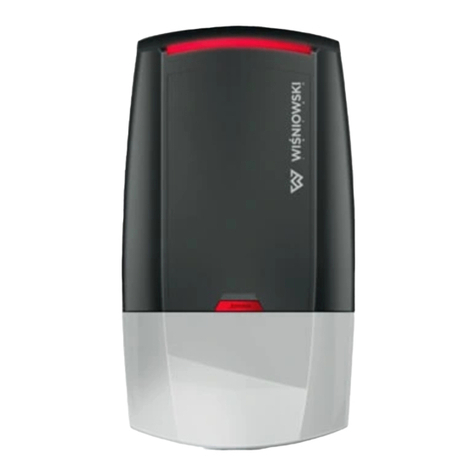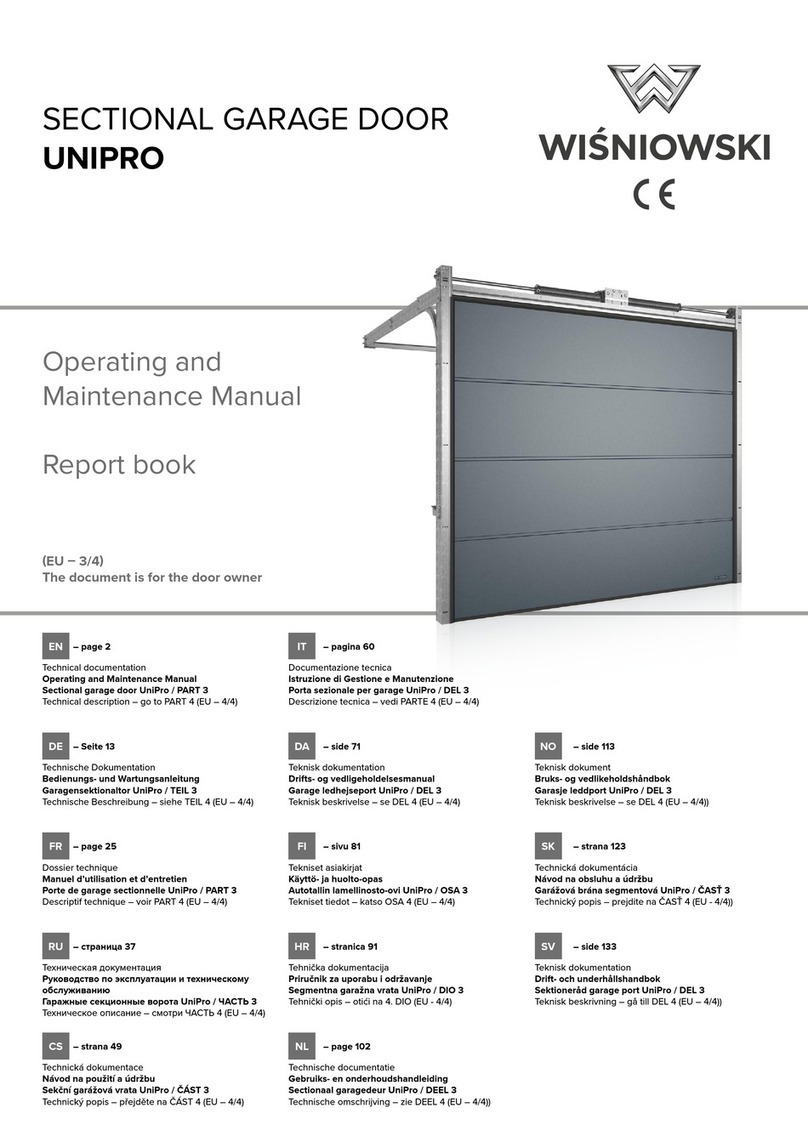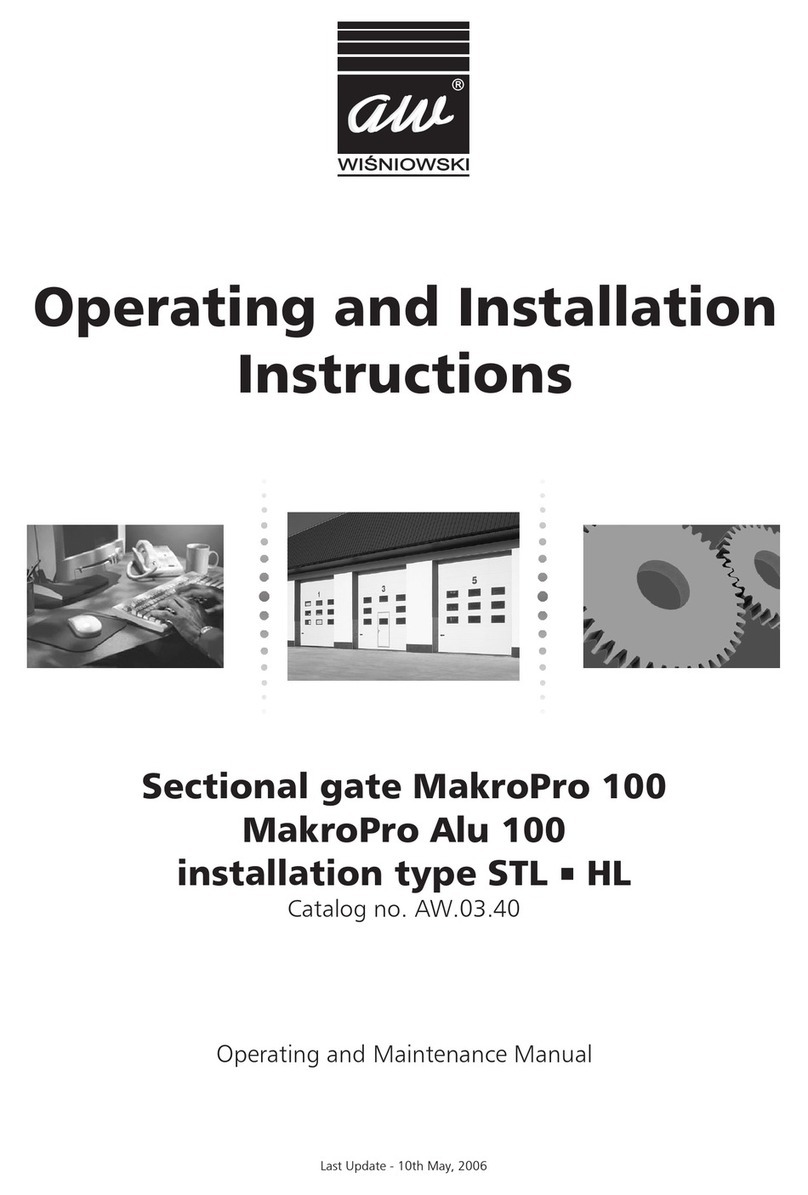Assembly and Operating Instructions – Drive unit for garage doors MIDO
3
EN
Technical Description IIiO/MIDO/07/2012/ID-93341
Installing the operator in a room which requires more
working (plastering, gypsum works, grinding, painting,
etc.) is not allowed. Installing the drive in an explosion
risk area is not allowed.
A proper garage ventilation should be provided (drying). The drive is to be
installed by a professional installer or other competent person only and in line
with this instruction.
[D000140] The required header capacity is >500N.
[B000027] Safety conditions
• The wiring system and the electric shock protection installations are defined
by current norms and regulations.
• The drive feed circuit should be equipped with a cut-off protection, a residual
current circuit-breaker, and an overcurrent protection.
• The drive feed system should be executed as a separate electrical circuit.
• Obligatory grounding should be made in the first place.
• When installing the drive, the wires delivered by “WIŚNIOWSKI” sp. z o.o.
sp.k. with the drive should be used.
• Electrical wiring must be executed according to local regulations.
• Only a qualified installer my perform electrical works.
• The door and the drive set must comply with PN-EN 12453, and PN-EN
12604 standards.
• MIDO drive complies with the following EU directives:
• Low Voltage Directive 2006/95/EC
• Machine Directive 2006/42/EC
• Electromagnetic Compatibility Directive 2004/108/EC
• Radio and Telecommunications Terminal Equipment Directive 1999/5/EC.
• [C000081] The drive must not be installed in an explo-
sion risk environment. Presence of flammable gases
and vapours is a major risk factor.
• [A000026] Keep the packaging (plastics, polystyrene,
etc.) out of the reach of children.
[D000144] 7. INSTALLATION INSTRUCTIONS
Preparatory activities include preparation of the wiring system. A rough layout of
the device components and wire arrangement is presented in figure 2.
Electrical wiring must be made by local regulations.
Only a qualified installer my perform electrical works.
[D000145] Garage ceiling must provide safe installation of the drive. If the
ceiling is too light or too high, or the drive mass exceeds 20 [kg], then it should
be mounted on a support structure adequate to room conditions. Mounting the
door or the drive fixing elements in a way that allows their dislocation during
operation is not allowed.
[C000084] Correct drive operation to a large degree depends on its correct
installation. On an extra order, “WIŚNIOWSKI” sp. z o.o. sp. k. performs instal-
lation itself or recommends authorised installation companies. Only installation
and maintenance done by competent persons or companies, in line with this
instruction, may guarantee safe and intended operation of the drive.
[D000146] Before drive installation, make sure that the door the drive is mount-
ed on has been mounted and adjusted correctly and opens and closes easily.
Also dismantle the fixing parts and the drive components which do not require
power supply.
The drive must not be installed with a non-operational
door. Disconnect the drive from power source before
proceeding with the installation works. Also a battery
power supply should be disconnected if it has been delivered.
[C000085] Correct operation of the door and the drive unit to a large extent
depends on the drive correct installation. To avoid malfunctioning, premature
wear or warranty loss of the drive, this instruction has to be strictly followed.
[D000147] The drive is delivered with fixing elements to apply to concrete; for
walls made of other materials different fixing elements may be required.
[C000086] If a wicket door is fitted in the garage door you must check if the
fixed elements do not protrude into a public pavement or road.
[D000259] 7.1. INSTALLATION SEQUENCE
Fig.3. Install the catch plate for the “Ru” up-and-over door leaf. The catch
plate is mounted in the middle of the door leaf.
Fig.4. Install the catch plate for the sectional door. The catch plate is
mounted in the middle of the door leaf. In the sectional doors with
the top panel cut, the leaf catch plate is delivered with the door.
Fig.4.7 Acceptable installation of a sectional door leaf catch plate; fixing
elements are not delivered with the drive.
The presented holes level for the door leaf catch plate
applies to doors manufactured by “WIŚNIOWSKI”
sp. z o.o. sp. k., in case of other doors the height
should be decided on by the client.
Fig. 5-6. Mark out installation holes for the header catch - in the header.
Fix the header catch to the header 20-150[mm] above the shaft or
above the door leaf catch plate (as offered by a free installation
space). Fix the metal slide rail to the catch with the “L” bolt. Fix
the drive to the slide rail with a “K” catch. Tighten with a 2[Nm]
torque. Fix the drive catch as close to the engine as possible, if
there is enough space.
Important: Make sure the slide rail is levelled towards
the door shaft.
Make sure that the “S” slide rail suspension brackets are fixed well
to the ceiling. Fix the slide rail with the dedicated “J” metal suspen-
sion bracket (depending on “v1” or “v2” design version).
Fig.3.1c, Fig.7. Connect the door leaf with the drive by means of the connec-
tion strip.
Fig.8. Fasten the coupling cord. The cord should be fastened at the height
below 1800 [mm] from the floor. Unlock the drive by pulling the
cord, attempt to open and close the door by hand. Make sure there
is no resistance between the door panel and the drive guide.
Fig.9. Mount a door leaf catch plate on the door and the “Rs” unlocking.
Connect the door leaf with the drive by means of the connection
strip.
Fig.8. To open the garage door in a blackout the drive must be unlocked
with the cable. The drive is provided with a function of the hoist
disengagement with a cable. Pull the cable to unlock the garage
door drive. To reengage the drive shift the lever, the cable is fixed
on, back to the original position. When the garage door is not
fitted with a wicket door, an external unblocking mechanism is
recommended. The cable handle should be mounted not higher
than 1800 [mm] above the floor.
• [D000273] Unlocking is not allowed when the drive is
operating, as this can cause permanent damage to the
drive. Pulling the drive unlocking cable with the whole
body weight is not allowed.
• [D000274] Take special care when unlocking the drive
manually: the opened garage door can fall if springs
are weak or broken or if the door is not balanced in
the right way.
[D000149] 7.2. PHOTOCELLS CIRCUIT DIAGRAM
Photocells connection to the control panel is presented in fig.19.
[D000172] 7.3. BELL-PUSH CIRCUIT DIAGRAM
Bell-push connection to the control panel is presented in fig.29.
[D000151] 7.4. El3Q RADIO RECEIVER CIRCUIT DIAGRAM
Radio receiver connection to the control panel is presented in fig.39.
[D000260] 7.5. DRIVE INSTALLATION ERRORS
Errors may occur when installing the drive, but they are easy to avoid when the
following steps are taken:
• the drive slide rail mounted and balanced properly, in line with data found
in this instruction,
• correct drive supply voltage,
• unlocking mechanism adjusted correctly,
• all connections parts tightened well.
Disregarding these basic recommendations may cause malfunctioning, damage
or warranty loss of the door.
[A000027] Extra requirements
On completing the installation, check if the door has a standard CE rating
plate, provide it if not. When you verify the drive operates correctly, submit
the drive Assembly and Operating Instruction to the owner. Apply warning
stickers in a way they are stable, visible, and close to the door or the control
panel.
[A000008] 8. ENVIRONMENT PROTECTION
Packaging
Packaging components (cardboard, plastics, etc.) are classified as recyclable
wastes. Dispose of them according to relevant local regulations.
Scrapping
This product consists of various materials. Most of them are recyclable. Segre-
gate them first, and then deliver to a recycling plant.

































